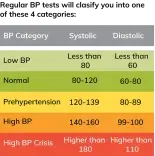Blood Pressure
Blood pressure (BP) is the pressure of circulating blood against the walls of blood vessels. Most of this pressure results from the heart pumping blood through the circulatory system.
When you have your blood pressure measured, you will be given two numbers, a top number and a bottom number. The first, or top, the number is the Systolic blood pressure and indicates the highest level your blood pressure reaches when your heart beats, forcing blood around your body. The second number, or bottom number, is Diastolic blood pressure which is the lowest level your blood pressure reaches as your heart relaxes between beats.
Blood pressure is measured in millimetres of mercury (mmHg). If the first number is 120 and the second number is 80, this would be written as 120/80mmHg, and you’d call it ‘120 over 80’.

Normal BP is usually a sign of a healthy heart. The other 3 categories are signs of either an existing disorder, disease or worsening health and require the person to pay immediate attention to their diet and lifestyle in order to bring their BP within normal range
Methods of measuring BP
There are broadly 2 ways to measure BP - invasive and non-invasive.
1. Invasive BP (IBP)
Invasive Blood Pressure is measured in ICU by puncturing an artery & inserting a cannula needle in an artery & is by far the gold standard in BP measurements. It gives continuous blood pressure waveforms. However, this method involves the puncturing of the arteries which requires highly skilled personnel, is an expensive procedure and yet damages the artery.
2. Non-invasive BP (NIBP)
Non-invasive blood pressure is measured conventionally using a cuff-based BP monitor - a mercury sphygmomanometer and stethoscope or a digital BP monitoring device. Newer breakthroughs in technology have made it possible to measure BP in a cuffless way - at the wrist (using smart wristbands or smart watches).
Contactless BP monitor
For the first time, a contactless BP monitoring method has been proposed and researched by the team at Dozee. Our novel methodology has given results that qualify for medical grade use as per the accuracy levels set by BHS/AAMI/ISO standards.
A significant breakthrough in continuous non-invasive BP monitoring, Dozee’s method of BP monitoring has given similar results on SBP values ranging from 70 mmHg to 350 mmHg and DBP values ranging from 20 mmHg to 170 mmHg.
The need for Calibration of BP
Calibration is the process of setting a baseline for the subject’s BP values and corresponding BCG indicia at that baseline BP. It is necessary to capture certain constants and baseline values specific to the subject like Systemic Vascular Resistance (SVR), arterial compliance, preload, afterload, etc.
Getting this information is vital because the variation in a person’s blood pressure is being estimated in a contactless manner. However, this contactless method is devoid of the luxury that a cuff-based BP monitor or IBP monitor has, where a load cell or an inserted needle can be used to directly measure BP.
We are using the changes in the BCG signal to estimate the change in BP in response to predetermined BCG indicia.
Hence a baseline is required to give the absolute value of BP basis the change predicted by us. That baseline value is obtained by the process of calibration.


